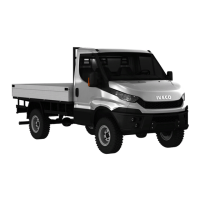16
DAILY 4x4 ‒ GUIDELINES FOR BODYBUILDERS
CHASSIS INTERVENTIONS
2.4 WHEELBASE MODIFICATION
– Printed 692.68.999 – 3 Ed. - Base 08-2020
tance of at least 1500 mm upon work completed). Carry over the points relative to the cutting area between the two lines;
proceed as instructed in Paragraph "Welding" ( ➠ Page 8);
●
before welding, check that the side members and any added parts are perfectly aligned and perform the check measure-
ments on both sides and along the diagonal line, as previously indicated. Apply the reinforcements as in Paragraph "Welding"
( ➠ Page 8).
Additional information
● Protect the surfaces against oxidation as in Paragraph "Added or modified parts" ( ➠ Page 12).
● Restore the braking and electrical systems as according to Chapters 2.15 ( ➠ Page 36) and 5.4 .
● Follow the instructions in Chapter 2.8 for interventions on the driveline.
2.4.6 Verification of the chassis stresses
With regard to wheelbase elongation, aside from local reinforcement in the joint area of the side members, the Bodybuilder must
also account for reinforcements - along the entire contour of the wheelbase - until achieving area strength modulus equal to
IVECO values for the same wheelbase or for the next admissible greater length. In alternative, for cases allowed by local standards,
larger subframe profiles can be adopted.
The Bodybuilder must make sure that the stress limits prescribed by national standards are respected. These stresses must not
be greater than those or the original wheelbase frame, assuming an evenly distributed load and considering the frame as a beam
positioned in place of the suspension supports.
When an elongation is performed starting from the longest original wheelbase, the reinforcements adopted must account for
wheelbase elongation, type of chassis produced and vehicle use.
2.4.7 Cross members
The need to apply one or more cross members is subordinate:
● to the entity of lengthening;
● to the position of the transmission support;
● to the welding area;
● to the points where forces caused by superstructures are exerted;
● to the vehicle's conditions of use.
Any additional cross members must have the same characteristics of those already mounted on the frame (bending and torsion
strength, material quality, connection to side members, etc.).
2.4.8 Reinforcements on the chassis
Figure 6 shows some examples of possible solutions.
The reinforcements must be continuous and extend over the entire length of the vehicle's chassis, up to the cab. To connect them
to the side member, in the case of an angle profile, rivets or screws of resistance class 8.8 must be used; diameter and distribution
must ensure that the profile provides the expected reinforcement resistance.
We recommend creating a cut-resistant joint in the area of the rear overhang and for about half of the wheelbase length (and
always for lengths of at least 2 m from the front axle).
On the chassis converted in this way, bending stresses must be envisaged that do not exceed those of the chassis of the original
vehicle in the corresponding sections.

